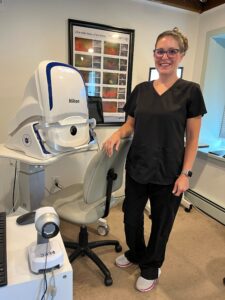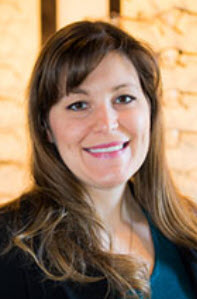
Dr. Richard in her pre-testing room with her Optos California, part of a suite of instrumentation and new protocols that has helped her to better serve diabetic patients.
How an OD can grow their diabetic patient base with key actions and investments.
By Melissa Richard, OD
August 30, 2023
Diabetes now affects 37.3 million Americans, according to the Centers for Disease Control and Prevention (CDC). That translates into many diabetics needing comprehensive eyecare services. Here is how my practice is focusing on expanding these services.
Room for Growth
I have about 400 patients with a diabetic diagnosis, making up approximately 7.5 percent of my patient base. About a third of them have diabetic retinopathy. I see the patients without diabetic retinopathy yearly. I see the ones with diabetic retinopathy at least every six months depending on their severity.
Diabetic retinopathy patients have a RETeval ERG and either an OCT or fundus photos at their visit. These services generate $175-$200 in revenue twice a year for each diabetic retinopathy patient, along with the revenue from their office visit. In addition, some patients purchase the EyePromise DVS supplements we sell. So far, all of this adds up to around $50,000 annually in my practice. We are taking actions and making investments, however, to ensure this is just the start of how far we can grow the diabetes eyecare portion of our practice.
I would estimate that the diabetes care portion of our practice has grown 5 percent over last year already due to our new testing protocols and the sale of more supplements.
Building Bonds with Primary Care Providers
Within my first year of practice, when things were not as busy, I would go out to visit primary care offices. I brought chocolate for the staff, dropped off an introduction letter and business cards. The letter discussed optometry’s role in treating diabetic patients and also highlighted some of the technology my office uses (such as the optomap digital retinal scan and the OCT) and services we offer in addition to comprehensive eye exams (emergency visits, foreign body removal, etc).
However, the most important thing we did to get referrals from primary care providers was to send letters promptly regarding the patient’s retinopathy status. We have a template, which we could quickly complete, and fax to their primary care and/or endocrinologist immediately after their exam.
Invest in Key Instrumentation to Serve Diabetic Patients
Optos – I started with the Daytona, which was approximately $70,000 with my Vision Source discount, but recently upgraded to the California for $60,000 with the trade-in and Vision Source discount. I use the optomap as a screening test for patients who opt for it during their comprehensive exams (we charge $40 out of pocket). We use it as fundus photography for medical patients, which reimburses an average of $60 per patient.
OCT – I started with a refurbished OCT for about $40,000, but it eventually died. I purchased a new Optovue (now Visionix) in early 2020 for $30,000 with my Vision Source discount. We offer a “Wellness Package” that combines the Optomap and the OCT iWellness exam to all of our comprehensive patients (the package is $60 out of pocket). The iWellness exam looks for early signs of glaucoma, AMD and diabetic changes. We also use the OCT to monitor glaucoma patients and for our patients with macular disease. Each test reimburses an average of $33 from medical insurance.
Other Articles to Explore
I currently have my eye on possibly adding the Visionix Solix OCT-A to our office. The OCT-A provides visualization and quantification of retinal vasculature and can detect changes in the foveal avascular zone before we can see these changes by looking in the eye.
RETeval ERG – I purchased this from LKC Technologies earlier this year for about $20,000. I use it on AMD patients, glaucoma patients and patients with other optic nerve diagnoses and diabetic retinopathy patients. The test is reimbursed an average of $140 from medical insurance.
The RETeval ERG is an objective tool to measure the risk of diabetic retinopathy (DR) progression. The DR Assessment Protocol combines a white light flicker ERG to measure cone bipolar cell function with pupillary function testing. It provides me with a Risk Assessment score. A score of 23.5 or higher indicates an 11-fold risk of requiring intervention within three years. It is objective, non-invasive, doesn’t require dilation, only takes about two minutes to perform, and is easy to interpret.
Bill Accurately for Services Provided
I bill by time for office visits using the 99xxx codes since I often spend more time talking and counseling patients on the effects of diabetes on the eyes. Most patients with a vision plan will use that for their comprehensive exam. If they have diabetic retinopathy, I have them come back under their medical insurance for an office visit, RETeval, and either fundus photos or OCT. Photos and OCT cannot be billed on the same visit, but the RETeval can be billed in conjunction with both codes.
Use Technology to Show Patients Need for Regular Eyecare & Screenings
The greatest challenge in managing diabetic patients is getting them to understand the risk of vision loss with the disease and ensuring they are compliant with treatment to prevent vision changes. The most powerful tool I have is the optomap. With this technology, I can show them their retinas, and whether or not they have retinopathy. Seeing what I’m looking for makes it more real to them. I’m also excited about the RETeval because it gives the Risk Assessment score, something for the patient to keep track of and work on lowering their risk.
Accommodate Refraction Needs of Patients with Fluctuating Blood Sugar
Blood sugar can impact refraction. During hyperglycemia, excess glucose in the lens is converted to sorbitol which is poorly permeable so it accumulates in the lens. Water from the aqueous enters the lens through osmosis and causes lenticular thickening, and, therefore, refractive changes.
When I find a significant change in refraction in a diabetic patient, I ask about their current level of blood sugar control. If possible, I have them return for a repeat refraction in 3-4 weeks before getting new glasses (assuming they can improve their blood sugar in that time). If the vision is so poor with their current correction that they can’t wait, I make sure they understand our remake policy on glasses, and try to bring them back for a repeat refraction within the window of our lab’s remake policy.
In contact-lens wearers who have a large refractive shift, I give them a trial contact lens in the new prescription, but have them return for a repeat refraction before finalizing the prescription.
Make Staff Partners in Caring for Diabetic Patients
Our technicians know to ask diabetic patients for their last A1c and fasting blood sugar levels. They also ask for their primary care provider and endocrinologist if they have one, so I can send them a letter with the results of their exam.
With good communication with patients and co-managing physicians, and the right technology investment, our diabetic services are poised for strong growth. This is good news both for the diabetic patients who need our care and our practice’s profitability.
 Melissa Richard, OD, MS, is the owner of Spectrum Vision, Chalfont, Penn, a Vision Source practice. To contact her: mrichard@spectrumvision.com
Melissa Richard, OD, MS, is the owner of Spectrum Vision, Chalfont, Penn, a Vision Source practice. To contact her: mrichard@spectrumvision.com

























